
Characterization of buffalo-derived theilerial parasites with monoclonal antibodies and DNA probes
Abstract
The characteristics of intra-lymphocyticTheileriaisolated from African buffalo and from cattle that were infected with buffalo-derived parasites were evaluated using anti-schizont monoclonal antibodies (mAbs) and DNA probes. Antigenic differences were revealed by the reactivities of 27 mAbs with the buffalo-derived parasites isolated from different animals. Antigenic diversity was also seen withTheileria-infected lymphoblastoid cell isolates taken from the lymph nodes and blood of the same animals. Two DNA probes, selected from a genomic library ofT. parvapiroplasm DNA cloned inλgt11, showed specific hybridization to parasite DNA in Southern blots of restriction enzyme-digested, lymphoblastoid cells infected with buffalo-derived theilerial parasites. Genotypic differences between the buffalo-derived parasites were revealed by the restriction fragment length polymorphisms seen with hybridization of those probes to DNA from cloned and unclonedTheileria-infected cell lines. The evaluation of theilerial parasites derived from buffalo and from cattle which underwent typicalT. p. lawrenceireactions, after being infected with buffalo-derived theilerial parasites, did not show any specific phenotypic or genotypic characteristics of these parasites that would distinguish them fromT. p. parvaandT. p. bovisparasites. The validity of these subspecies distinctions is discussed.
Citation
Parasitology;98: 179-188









